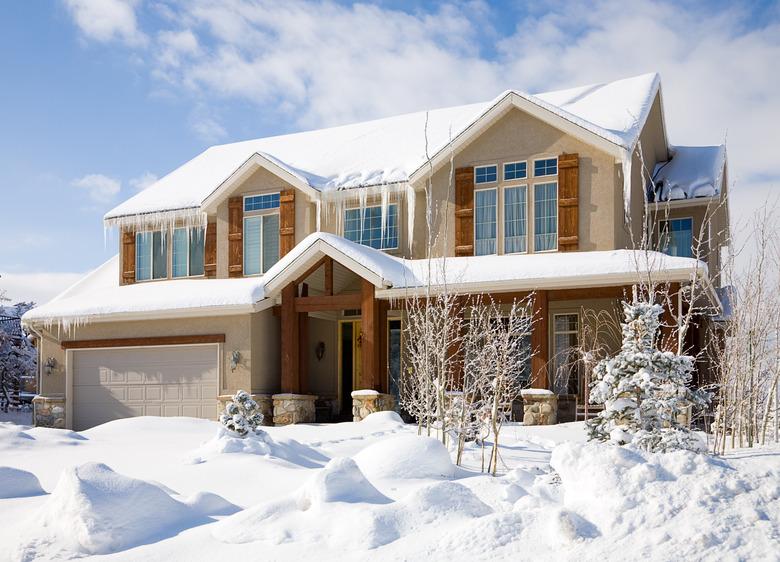Types Of Snow Mold And How To Get Rid Of It
We may receive a commission on purchases made from links.
The term "snow mold" refers to fungal diseases that affect turfgrass. There are two types of snow mold, commonly called pink snow mold and gray snow mold. They have slightly different characteristics, but both provide a shock to homeowners when the snow cover on their lawn melts. Instead of healthy turf, they find unsightly and damaging patches on the grass.
Types of Snow Mold
Types of Snow Mold
Pink snow mold — or, more technically, Microdochium patch — is caused by the fungal pathogen Microdochium nivale. When the snow melts, you may find small spots that are about 8 inches in diameter. They start out orange to reddish-brown in color and then turn light tan with pink edges. Pink mold survives in plant debris until fall.
Gray snow mold, or Typhula blight, is caused by Typhula incarnata. It causes large spots that are 1 to 3 feet in diameter. The blight causes the grass to turn yellow or gray. It is usually accompanied by mycelium, a gray-white fluffy substance that resembles spider webs.
Both types of snow mold are unsightly, but pink snow mold can damage and kill the entire grass plant down to the roots. Gray snow mold usually only affects the grass blades.
Snow molds become inactive during warm, dry weather, but they are only dormant. Gray snow mold produces tiny structures called sclerotia that you can see on the grass blades. They germinate when the weather turns cold and wet.
Causes of Snow Mold
Causes of Snow Mold
The fungal pathogen causes the mold, but there are environmental triggers that can jump-start the problem. A covering of snow allows the two types of snow mold to develop. Especially damaging is an early snow that accumulates before the ground freezes. The warm soil melts the lower level of snow, while the unmelted snow holds moisture near the surface, creating a prime breeding ground.
Anything trapped under the snow can contribute to the problem. That includes leaves, garden debris and even long blades of grass that become matted down. A thick layer of thatch (or dead grass and debris that accumulates on the surface of the soil that keeps the soil from drying out) on the lawn can also help the two types of snow mold develop.
Many gardeners fertilize their lawns in the fall, which in some cases is a good idea. However, when the fertilizer is applied too close to the first snowfall, the lawn is green and growing when it should be going dormant, which can lead to snow mold.
Dealing With Snow Mold
Dealing With Snow Mold
Many homeowners automatically reach for a fungicide when they discover snow mold, but by the time the mold is discovered in the spring, it is too late because the damage is already done. The best course of action is to give the lawn a good old-fashioned raking. You will collect any dead debris and help aerate and dry out the soil. This alone coupled with the change of weather can help some areas recover on their own.
However, there is a good chance that some areas won't recover and that the grass will remain matted and dead. For those areas, repair the damage by reseeding. When the danger of frost has passed, clear away the dead turfgrass. Follow the package directions on how to prepare the soil, sow the seed and grow and care for the new grass.
Preventing Snow Mold
Preventing Snow Mold
The best way to deal with snow mold is to try and prevent it from taking hold. There are a variety of ways to eliminate the problem before it even begins.
- Remove thatch. Dethatch the lawn as needed but especially in the early fall using a dethatching rake. Dethatching gets rid of dead organic material that can contribute to snow mold.
- Remove leaves. Don't let whole leaves overwinter on the lawn. Either rake them up or use a mulching mower to chop them up (leaving them on the lawn) so they can break down and supply nutrients to the soil.
- Cut grass shorter than usual. During the last mowing of the season, lower the mower blades so that the lawn is about 1 to 1 1/2 inches shorter than usual. Do this when the grass is starting to go dormant for the season. Short blades are less likely to become compressed and matted under the snow than long grass.
- Apply a fungicide. Most homeowners won't need to do this, but if snow mold is a recurring problem, you can apply a preventative dose of lawn fungicide in the fall.
- Fertilize at the right time. If you do fertilize in the fall, apply it at least six weeks before the first expected snowfall in your area.
